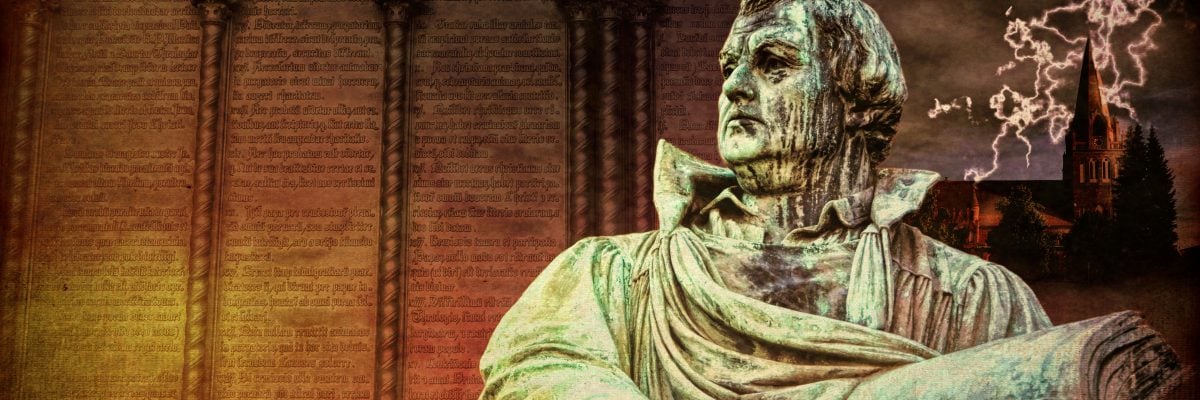
October marks the 500th anniversary of the Protestant Reformation. Secular and religious media will feature stories about the main leaders of the Protestant movement, Martin Luther (1480-1546) and John Calvin (1509-1564). Most of those stories will paint them as holy and upright men appalled at the impiety, superstition, and corruption in the Catholic Church and dedicated to returning the Christian Faith to its pristine original form. But is that the real story of these men?
Martin Luther had a difficult childhood, owing to his overbearing and sometimes abusive parents. His father wanted Martin to study law, but after a frightening near-death experience, Martin decided to enter an Augustinian monastery. His academic brilliance landed him a teaching job at the University of Wittenberg in 1508.
Luther suffered throughout his life from various physical and spiritual ailments. He was desperate for certain knowledge of his own salvation and came to believe that it is through faith alone (sola fide) that one is saved. He adopted the heresy that Scripture alone (sola scriptura) is the authoritative source of divine revelation.
Luther’s extremely negative image of God, which may have reflected that of his abusive father, influenced his theology and his conflicts with authority. To Luther, God was not a loving father, as revealed by Christ, but rather a tyrannical and wrathful judge who delights in tormenting sinners.
Luther posted his Ninety-Five Theses on the church door in Wittenberg on October 31, 1517. Although many of the theses dealt with ecclesiastical abuses, Luther’s contention that the pope had no authority to grant indulgences was outright heresy, and in 1520 Pope Leo X condemned it and forty other erroneous teachings.
Luther’s response in the form of three treatises published late that year laid the foundations for his revolution against the Catholic Church. In these treatises, he appealed to the German nobility to nationalize the Church in Germany and free it from Roman control. He also attacked the sacraments, denying that they are channels of efficacious grace when faith is absent. In the treatise he addressed specifically to Pope Leo, he denied free will, and he later called for the suppression and eradication of the Mass.
Luther’s revolutionary writings led to outbreaks of violence throughout Germany. By 1525, mobs had destroyed churches, burned sacred art, and profaned the Eucharist. Nobles sympathetic to Luther’s teachings appealed to him for help ending the violence. In response, Luther wrote a pamphlet titled Against the Murderous, Thieving Hordes of Peasants, in which he called on the nobility to suppress the rebellion with all necessary violence, which they did with ferocious efficiency, killing 130,000 peasants. That same year Luther married a former nun whom he helped “escape” from the convent.
Several years later, Luther’s break with Christian teaching on marriage was made complete when he advised one Philip, landgrave of Hesse, that he could enter into a bigamous marriage so long as he kept it secret. When word of it leaked out, Luther advised Philip to deny it, writing, “What harm is there in telling a good bold lie for the sake of making things better and for the good of the Christian Church?”
Toward the end of his life, Luther wrote On the Jews and Their Lies, a treatise in which he put forth an eight-point plan to rid Germany of its Jews. In Luther’s last treatise before his death in February 1546, Against the Pontificate at Rome, Founded by the Devil, he called for the torture and murder of the pope and cardinals.
John Calvin was of a different temperament than Luther. Whereas Luther was bombastic, rude, crude, and vulgar, Calvin was studious, quiet, and refined. Despite their differences, Calvin was just as much a revolutionary, and it was he who began what Catholic historian Hilaire Belloc called the “war against joy” in Geneva. Belloc pointed out that “it was the French spirit, but the northern French, the less generous, the people that have no vineyards, which produced Jean Calvin.”
By 1545, Calvin had created a theocracy in Geneva that enforced its own version of Christian morality upon the citizenry. Citizens were sometimes required to confess their sins in front of a civil magistrate and were subject to biannual visitation by a commission of elders and ministers. These commissions investigated whether the citizens attended church services regularly and lived moral lives in accord with Calvin’s creed, and classified them as “pious,” “lukewarm,” or “corrupt” in their faith. The death penalty was prescribed for adultery, blasphemy, idolatry, pregnancy out of wedlock, and striking a parent. It was also against the law in Calvinist Geneva to dance, sing (outside of church services), stage or attend theatrical plays, wear jewelry, or play cards or dice.
Calvin railed against fellow Protestants when their theology did not agree with his. The most famous case involved Michael Servetus (1511-1553), whose 1531 work Seven Books on Errors About the Trinity landed him in trouble with the Spanish Inquisition. He fled Spain for France, where he began writing letters to Calvin asking his opinion on various points of theology. Servetus disputed Calvin’s answers, as well as many of Calvin’s teachings in his Institutes of the Christian Religion.
When a marked-up copy of the Institutes arrived from Servetus, Calvin became incensed and vowed, “If he [Servetus] comes [to Geneva], I will never let him depart alive.” When in 1553 Servetus did come to Geneva, Calvin spotted him, and he arrested, tried for heresy, convicted, and burned.
Martin Luther and John Calvin were complex men who were anything but the pious reformers of modern myth. They viciously attacked their critics. Luther’s writings spurred an armed rebellion in Germany that had to be forcibly put down by the nobility. Calvin created a theocracy in Geneva that interfered in the private lives of all citizens. Both men rebelled against the Catholic Church and contributed to the fracturing of Christendom, which persists to this day.
For more information on this and many other common anti-Catholic historical charges, see Steve Weidenkopf’s new book, The Real Story of Catholic History: Answering Twenty Centuries of Anti-Catholic Myths, available now from Catholic Answers Press.



